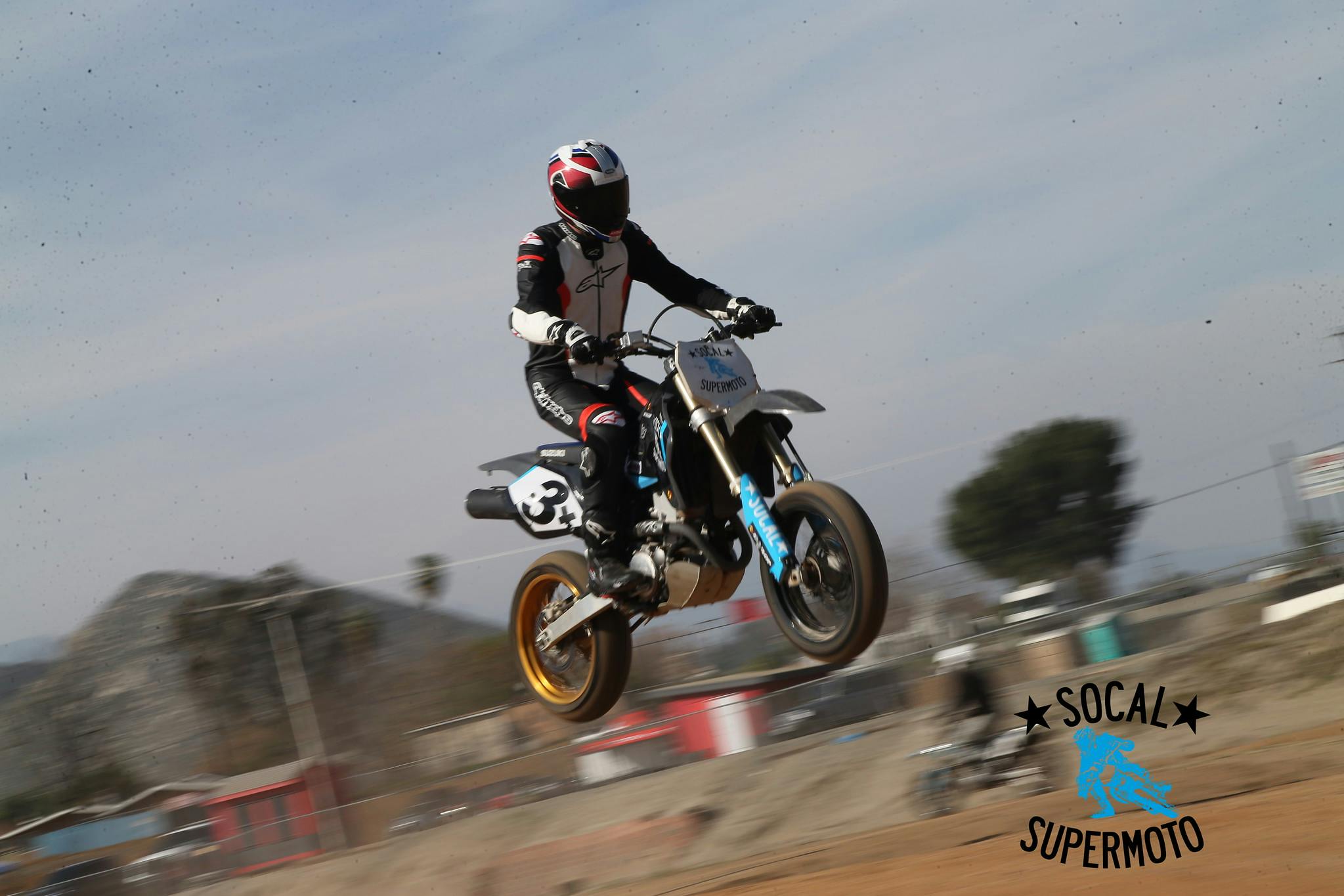Foot Out: Road racing on dirt taught me how to go faster
“It’s just kicking the apex, really.”
Brian Murray makes riding a supermoto — leg-out — sound so simple. We are a group 20 or so dudes (“dude” being the optimal descriptor for the type of person who shows up to SoCal Supermoto) sitting on folding chairs inside an office trailer, tucked in a corner of the Adams Motorsports Park paddock. The air contains some slight tension that will be broken once everyone fully suits up in riding gear and rolls out on track for the first time. Brian can feel it, too, but he doesn’t acknowledge it. The whiteboard behind him, on which instructors normally post homework in the form of tips to remember, is completely blank.
Instead we’re given our homework verbally, and it is fairly simple: three bullet points to keep in mind once we pull our helmets on. The third one is less of a tip and more of recurring mantra that at first garnered a collective chuckle from the peanut gallery as we sat in our leather and plastic shells: Don’t crash.
As the day went on and everyone got more comfortable with the track, racing line, bikes, and each other, it became clear that not crashing required real focus. Especially when the dirt sectioned open up. But we’ll get to that later.
We geared up. Boots, leathers, back protectors, gloves, and, of course, helmets. Each rider hopped onto one of the 25 Suzuki DRZ400SM motorcycles prepared by the small SoCal Supermoto crew. All were relatively basic setups and close to factory-condition, with Dunlop Q4 tires on the 17-inch front and rear wheels. The suspension adjustments were just about maxed out on rebound and compression in an attempt to stiffen up the chassis, and a couple small pieces of billet aluminum replaced the factory-fit rubber vibration dampers for a more direct steering feel. Otherwise these are the same $7500 bikes that Suzuki dealers have been selling since 2005.
Our first on-track session, at medium speed, focused on learning the racing line and, well, not crashing. A bonus lesson for me was realizing just how slick the painted curbing is on this course. After blowing the entry on one of the hairpins—because I was already trying to carry speed on the unfamiliar track—the bike tried its best to climb up onto the white and red edge of the track before nearly instantly shifting right back to the pavement, inducing a slide on the front tire. One of the fun things about a supermoto bike is the riding position and how it allows you to react and handle situations exactly like this. The big, wide handlebars slow down all your movements and inputs, while the leg-out position puts your whole body on top of the bike rather than hanging off the side. The result is a ton of feedback, and you still have leverage and weight to move around should the bike start to feel out of order.
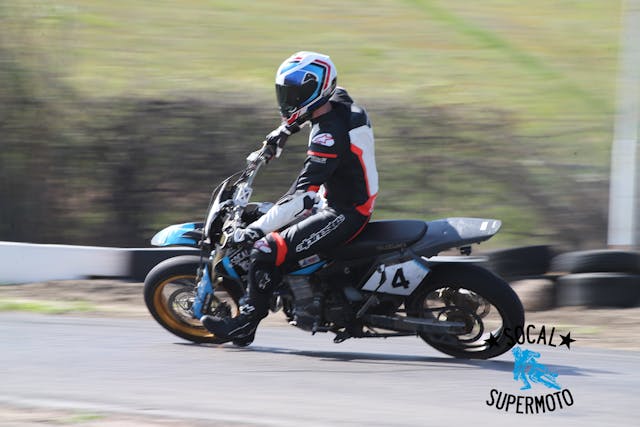
With 15 minutes of medium-speed riding under our belts, everyone’s nerves started to calm a bit. Brian explained to the group what our remaining laps that day could teach us. He moved from the “don’t crash” direction to focusing on what he calls “free speed.” It sounds unhinged, but in truth it’s a delicate combination of proper line choice, body position, and transitions between corners. One of the big takeaways from listening to Brian early in the day was his warning about simply imitating what faster riders look like they’re doing. Naturally, many of us are guilty of doing our best to copy the Rossi or Marquez riding position, albeit without the perfectly set up bike, experience, mental gameplan, attitude, or MotoGP-spec tires. It’s a recipe for failure, Brian says. It’s the difference between winning Instagram and winning races. Do you want photos that make you look badass or lap times that make you a badass?
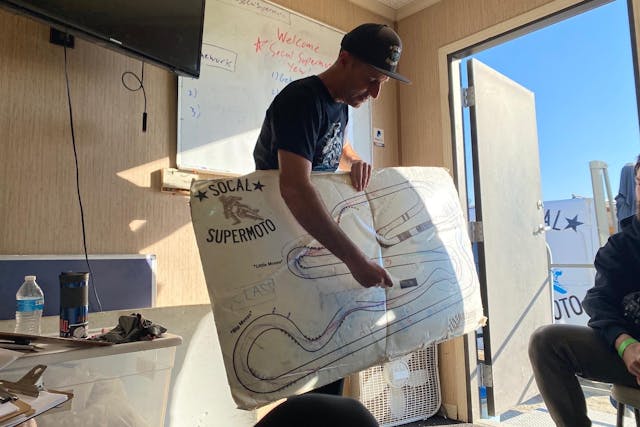
With each classroom and on-track session we got carefully measured amounts of guidance. It was so subtle that it took me a week before some of what I had learned fully set in and I realized sessions that felt like empty riding were in fact perfectly set up. It became clear that the team had been doing this school over a decade. The teaching was not obvious. A joke here, point there, eye contact while talking about something in particular all added up to near individual guidance if you paid attention. It takes energy to pay attention though, and even on a relatively small track and lower speeds energy disappears fast. Luckily right when the class was starting to feel the energy drain, a large delivery of pizza arrived. The people rejoiced.
One of the key items to true supermoto racing and events is the addition of a dirt section. These are off-road machines fitted with road race wheels and tires after all. The Adams Motorsports track has a tidy two-turn dirt section that was opened up for the afternoon. This detour cuts off a big sweeping right hand corner and instead guides riders into two hardpack berm corners before a nice measured launch across a tabletop jump–if you are so brave.
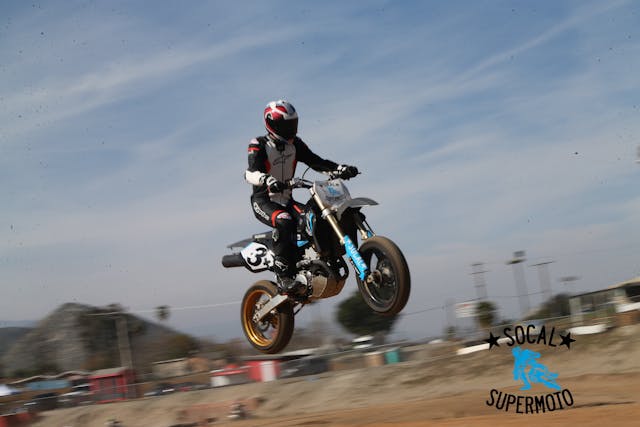
The addition of dirt required another acclimation session. A morning of what felt like road racing dirtbikes suddenly turned to an afternoon of dirt racing dirtbikes. So many road racers get comfortable using the rear brake minimally–and sometimes not at all–and we found out quickly who those riders were on what the SoCal team calls the “berm of destiny.” The hardpack dirt has no tolerance for front brake usage; the front end will disappear before you can even react if you let your brain go on autopilot during the dirt section.
Brian gave advice on the dirt that was really simple: just go slow. I knew I was guilty of going too fast in the slow sections. He pointed out the two hairpin corners and enlightened all of us that they were 5mph corners. Ride the slow parts slow and the fast parts fast. The guy with the lap record at this kart track goes slower than I do in those corners, yet is seconds a lap faster than me. Chase speed in the right places.
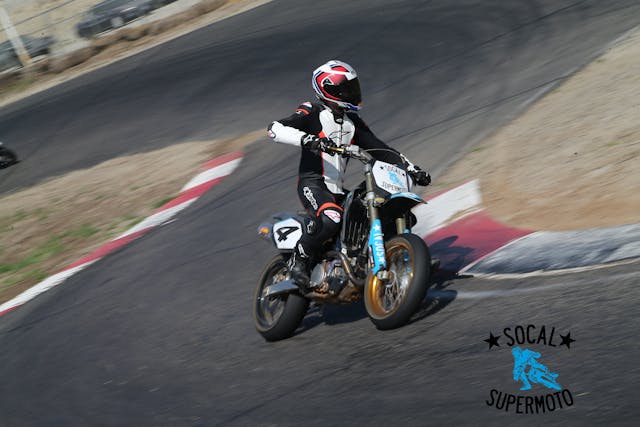
It was tips like this that added up to an awesome day of riding, learning, and just fun on track. It wasn’t til the end of the day that I truly understood all the knowledge that was imparted. Brian encouraged us take these two session and remember what got all of us into motorcycles in the first place: The fun of it. He pointed out that riding at 80% pace is actually pretty easy and is a whole lot safer than chasing the last tenth of a second. I took that advice, went out and just kicked apexes–and was faster than I’d been when I arrived to boot.



